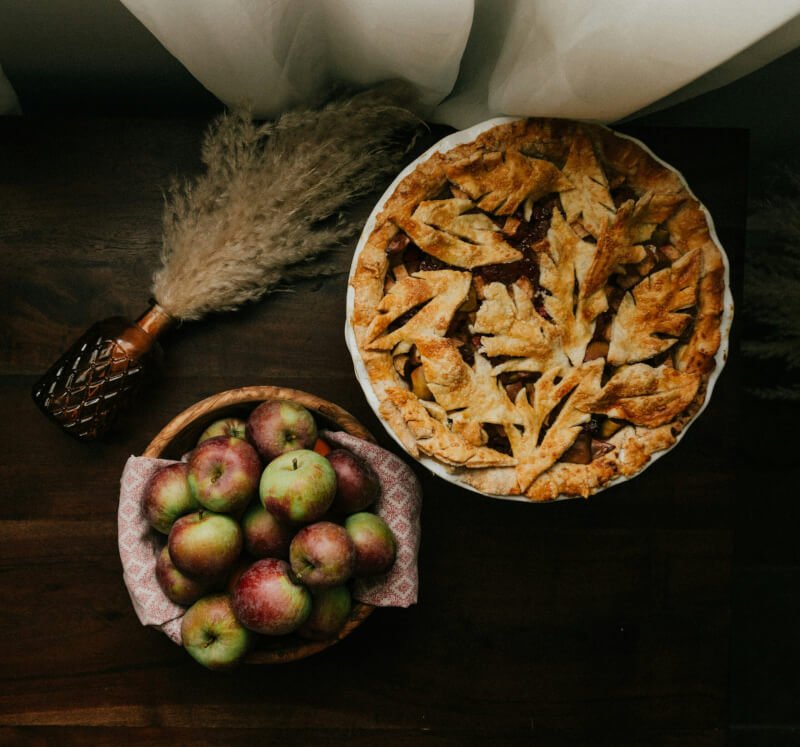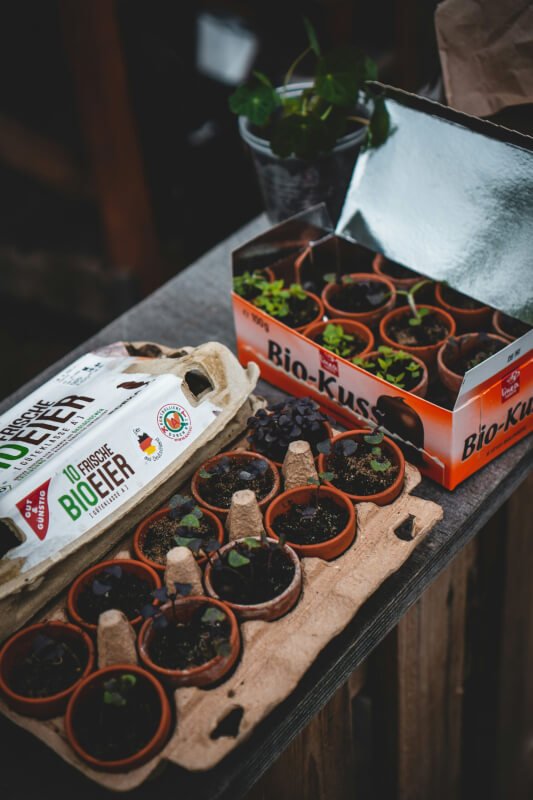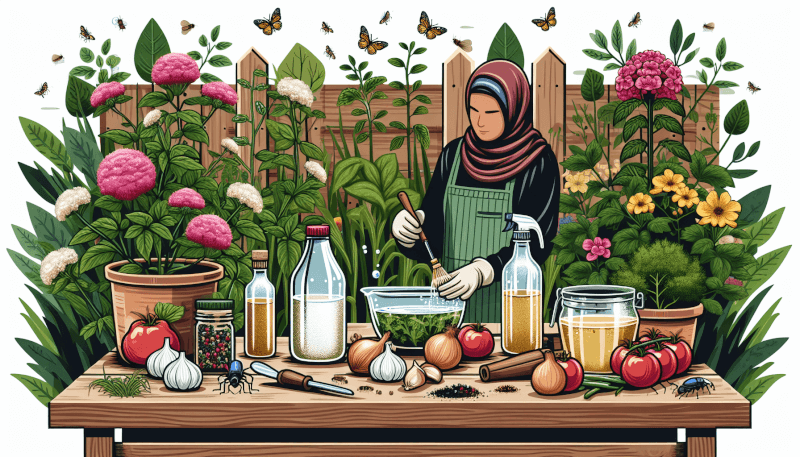If you’re an avid gardener looking for natural alternatives to commercial pesticides, this article is for you! We’ll explore DIY methods that allow you to make your own natural garden pesticides. Say goodbye to harmful chemicals and embrace these environmentally-friendly solutions to protect your plants from pests. Get ready to discover the power of ingredients found in your kitchen pantry and unleash your inner green thumb!

Soap Spray
Ingredients for soap spray
To make your own soap spray for your garden, you will need the following ingredients:
Liquid soap or dish soap: Choose a natural and biodegradable soap without any harsh chemicals.
Water: You’ll need water to dilute the soap and create your spray solution.
Instructions for making soap spray
Follow these simple steps to make your own soap spray:
Take a clean spray bottle and fill it with one quart of water.
Add two to three tablespoons of liquid soap or dish soap to the water.
Close the spray bottle tightly and shake it well to mix the soap and water thoroughly.
How to use soap spray in the garden
Soap spray can be an effective natural pesticide for your garden. Here’s how you can use it:
Identify the affected plants or areas in your garden where pests are present.
Spray the soap solution directly on the pests, focusing on the affected plants or areas.
Make sure to thoroughly cover both sides of the leaves and other plant surfaces with the soap spray.
Repeat the application every few days or as needed until the pest infestation is under control.
Remember that soap spray works by suffocating and dehydrating the pests, so it’s important to target them directly for it to be effective. Avoid spraying during hot sunny weather as it can potentially damage the plants.
Oil Spray
Ingredients for oil spray
To make your own oil spray to combat garden pests, gather the following ingredients:
Vegetable oil: Use a lightweight oil like canola oil or safflower oil.
Water: You’ll need water to dilute the oil and create your spray solution.
Dish soap: Add a few drops of liquid soap to help the oil mix with water.
Instructions for making oil spray
Follow these steps to create your own oil spray:
Take a clean spray bottle and fill it with one quart of water.
Add one to two tablespoons of vegetable oil to the water.
Add a few drops of liquid soap or dish soap to the mixture.
Close the spray bottle tightly and shake it well to emulsify the oil and water.
How to use oil spray in the garden
Oil spray can be an effective homemade pesticide for a variety of garden pests. Here’s how you can use it:
Identify the affected plants or areas in your garden that are infested with pests.
Spray the oil solution directly on the pests, targeting the affected plants or areas.
Ensure complete coverage of both sides of the leaves and other plant surfaces.
Reapply every one to two weeks or as needed until the pests are controlled.
Oil spray works by smothering and suffocating the pests, so direct contact is essential for its effectiveness. Test the spray on a small section of the plant before applying it to the entire plant to check for any adverse reactions.
Garlic Spray
Ingredients for garlic spray
To make garlic spray, you will need the following ingredients:
Garlic bulbs: Peel and crush a few garlic bulbs to extract the garlic essence.
Water: Use water as a base for diluting the garlic essence.
Instructions for making garlic spray
Here’s how you can make your homemade garlic spray:
Take a blender or food processor and add the crushed garlic bulbs.
Pour one quart of water into the blender with the garlic.
Blend or process the mixture until it becomes a smooth puree.
Pour the mixture into a clean spray bottle, filtering out any solid particles if necessary.
How to use garlic spray in the garden
Garlic spray is an excellent natural pesticide for repelling insects. Follow these steps to use it in your garden:
Identify the plants or areas in your garden that are prone to insect infestations.
Spray the garlic mixture directly onto the plants, ensuring that both sides of the leaves are covered.
Reapply the spray every few days or after rainfall to maintain its effectiveness.
Garlic spray works by repelling insects due to its strong odor. This method of pest control is best for deterring pests rather than killing them, making it a great preventive measure for your garden.
Hot Pepper Spray
Ingredients for hot pepper spray
To make hot pepper spray, gather the following ingredients:
Hot peppers: Use a variety of hot peppers such as chili peppers or jalapenos.
Water: Water acts as a diluent for the hot pepper solution.
Liquid soap: Add a few drops of liquid soap to help the spray adhere to the plants.
Instructions for making hot pepper spray
Follow these steps to create your own hot pepper spray:
Take a blender or food processor and add the hot peppers.
Pour one quart of water into the blender with the hot peppers.
Blend the mixture until it reaches a smooth consistency.
Strain the mixture through a cheesecloth or fine mesh sieve to remove any solid particles.
Add a few drops of liquid soap to the strained pepper solution and mix well.
How to use hot pepper spray in the garden
Hot pepper spray is an effective natural pesticide for deterring pests. Here’s how you can use it:
Identify the plants or areas in your garden that are affected by pests.
Spray the hot pepper solution directly onto the plants, covering all surfaces.
Be cautious while handling and applying the spray, as it may cause irritation to the eyes and skin. Consider wearing gloves and protective eyewear.
Reapply the spray every few days or after rainfall to maintain its repellent properties.
Hot pepper spray works by creating an unpleasant sensation for pests, especially insects. It acts as a deterrent rather than a lethal pesticide, making it a safe option for organic gardeners.

Neem Oil Spray
Ingredients for neem oil spray
To create your own neem oil spray, gather the following ingredients:
Neem oil: Purchase pure neem oil, which is known for its insecticidal properties.
Water: Dilute the neem oil with water to create the spray solution.
Liquid soap: Use a few drops of liquid soap to emulsify the mixture.
Instructions for making neem oil spray
Here’s how you can make your homemade neem oil spray:
Take a clean spray bottle and fill it with one quart of water.
Add two tablespoons of neem oil to the water.
Add a few drops of liquid soap to the bottle and mix well.
Close the spray bottle securely and shake it vigorously to emulsify the oil, water, and soap.
How to use neem oil spray in the garden
Neem oil spray is a natural pesticide that is effective against a wide range of garden pests. Follow these steps to use it in your garden:
Identify the affected plants or areas in your garden infested with pests.
Spray the neem oil solution directly onto the foliage, covering both sides of the leaves.
Reapply the spray every one to two weeks or as needed until the pests are controlled.
It is important to note that neem oil works by disrupting the life cycle of pests, preventing them from feeding and reproducing. Avoid applying neem oil under direct sunlight, as it can cause leaf burn. Test the spray on a small section of the plant before treating the entire plant to check for any adverse reactions.
Diatomaceous Earth
What is diatomaceous earth
Diatomaceous earth is a natural, powdery substance derived from the fossilized remains of diatoms, a type of algae. It is an effective pest control method due to its abrasive texture, which damages the exoskeletons of insects and ultimately leads to their demise.
How to use diatomaceous earth in the garden
Diatomaceous earth can be used in your garden as an insecticide. Here are some steps to effectively use it:
Sprinkle diatomaceous earth around the base of plants or affected areas in your garden.
Make sure to cover both the plant surfaces and the soil to create a barrier against crawling insects.
Reapply the diatomaceous earth after rainfall or heavy watering, as it may get washed away.
Diatomaceous earth is most effective when dry, so try to avoid applying it on a rainy day. It is safe to use around pets and humans, but it is recommended to wear a mask and goggles when handling it to avoid inhalation of the fine particles.
Precautions when using diatomaceous earth
While diatomaceous earth is generally safe to use, there are a few precautions you should keep in mind:
Avoid inhaling the dust: Wear a mask when applying diatomaceous earth to prevent inhalation of the fine particles, as they can irritate the respiratory system.
Use food-grade diatomaceous earth: Be sure to purchase food-grade diatomaceous earth, as the one meant for swimming pool filtration may contain harmful additives.
Keep away from beneficial insects: Diatomaceous earth is non-selective, meaning it can harm beneficial insects as well. Use it sparingly and avoid applying it to flowers where pollinators are present.
By following these precautions, you can utilize diatomaceous earth effectively and safely in your garden.

Homemade Insecticidal Soap
Ingredients for homemade insecticidal soap
To make your own homemade insecticidal soap, gather these ingredients:
Liquid soap or dish soap: Select a mild and natural soap without any harsh chemicals.
Water: Water acts as a base for diluting the soap and creating the spray solution.
Instructions for making homemade insecticidal soap
Follow these steps to create your own insecticidal soap:
Take a clean spray bottle and fill it with one quart of water.
Add two to three tablespoons of liquid soap or dish soap to the water.
Close the spray bottle tightly and shake it well to mix the soap and water thoroughly.
How to use homemade insecticidal soap in the garden
Homemade insecticidal soap can be an effective and gentle way to control pests in your garden. Here’s how you can use it:
Identify the plants or areas in your garden that are affected by pests.
Spray the soap solution directly on the pests, focusing on the affected plants or areas.
Thoroughly cover both sides of the leaves and other plant surfaces with the soap spray.
Repeat the application every few days or as needed until the pest infestation is under control.
Insecticidal soap works by disrupting the pests’ cell membranes, causing dehydration and ultimately leading to their demise. However, it is important to note that it may also harm beneficial insects. Use it selectively and avoid spraying during hot weather or when plants are stressed.
Essential Oil Sprays
Essential oils for natural garden pesticides
Essential oils can serve as effective natural pesticides to control garden pests. Some commonly used essential oils include:
Peppermint oil: Repels ants, aphids, beetles, and spiders.
Rosemary oil: Deters cabbage loopers, carrot flies, and mosquitoes.
Eucalyptus oil: Repels fleas, ticks, and mosquitoes.
Lemon oil: Controls ants, aphids, fleas, and flies.
Lavender oil: Deters moths, mosquitoes, and fleas.
Instructions for making essential oil sprays
Follow these steps to make your own essential oil spray:
Take a clean spray bottle and fill it with one quart of water.
Add 10-15 drops of your chosen essential oil(s) to the water.
Close the spray bottle tightly and shake it well to combine the oil and water.
How to use essential oil sprays in the garden
Essential oil sprays can be used as natural pesticides in your garden. Here’s how you can use them effectively:
Identify the plants or areas in your garden that are prone to pest infestations.
Spray the essential oil solution directly onto the plants, focusing on the affected areas.
Reapply the spray every few days or after rainfall to maintain its effectiveness.
It is important to remember that essential oils are potent and can cause skin irritation or allergic reactions in some individuals. Always dilute the oils properly and test the spray on a small area of the plant before applying it to the entire plant.

Companion Planting
What is companion planting
Companion planting is a gardening technique where specific plants are grown in close proximity to provide mutual benefits. It involves strategically planting certain crops, flowers, or herbs alongside each other to enhance growth, fertility, and natural pest control.
Beneficial companion plants for pest control
Here are a few beneficial companion plants that help control pests in the garden:
Marigolds: These vibrant flowers repel aphids, mosquitoes, and nematodes.
Nasturtiums: Their peppery scent deters whiteflies, aphids, and squash bugs.
Garlic: The strong odor of garlic repels a wide range of pests, including aphids and slugs.
Basil: This aromatic herb deters mosquitoes, flies, and tomato hornworms.
Chives: Their pungent smell repels aphids, Japanese beetles, and carrot flies.
How to implement companion planting in your garden
To implement companion planting in your garden, consider the following guidelines:
Plan your garden layout: Research and create a planting plan that incorporates companion plants alongside your desired crops.
Choose complementary plants: Select companion plants that have beneficial properties, such as pest-repelling scents or abilities to attract beneficial insects.
Interplant effectively: Plant companion plants in close proximity, taking care to match their spacing requirements with the main crop.
Rotate crops: Rotate the location of your main crops and companion plants each year to prevent the buildup of pest populations.
By implementing companion planting techniques, you can harness the power of nature to naturally control pests and promote the overall health and productivity of your garden.
Physical Barriers and Traps
Using physical barriers like netting and row covers
Physical barriers can be a highly effective method for excluding pests from your garden. Here are some types of physical barriers you can use:
Netting: Cover vulnerable plants with fine mesh netting to protect them from birds and insects.
Row covers: Use lightweight fabric row covers to shield plants from pests while allowing air and light to penetrate.
Floating row covers: These lightweight covers can be placed directly over plants to prevent insect infestations and protect against frost.
Creating traps for garden pests
Traps can help control specific pests by luring and trapping them. Here are a few types of traps you can create:
Beer traps: Bury small containers filled with beer to attract and drown slugs and snails.
Yellow sticky traps: Hang yellow sticky cards coated with a sticky substance to capture flying insects like aphids, whiteflies, and fruit flies.
Pheromone traps: Deploy pheromone traps to attract and catch specific insect pests like certain moths or beetles.
How to effectively use physical barriers and traps
Here are some tips for effectively using physical barriers and traps in your garden:
Identify the pests: Determine which pests are causing damage in your garden to select the appropriate physical barrier or trap.
Proper installation: Ensure that physical barriers cover the plants completely, with no gaps for pests to enter.
Regular monitoring: Check the traps regularly and remove captured pests to prevent them from breeding.
Maintenance: Repair or replace damaged barriers or traps to maintain their effectiveness.
Physical barriers and traps can be used in combination with other natural pest control methods to provide an extra layer of protection against garden pests. Adapt the use of physical barriers and traps based on the specific needs and challenges of your garden.
In conclusion, utilizing natural garden pesticides can be a sustainable and eco-friendly way to protect your plants from pests. From homemade sprays to companion planting and physical barriers, there are various DIY methods you can employ to maintain a healthy and thriving garden. By incorporating these strategies and being mindful of the specific needs of your plants, you can effectively control pests while minimizing the use of harmful chemicals. So grab your spray bottle or plan your companion planting layout, and enjoy the benefits of a pest-free garden!



